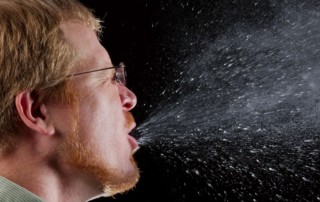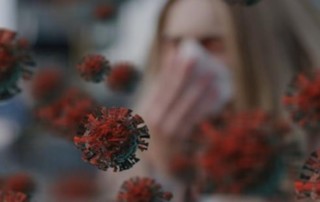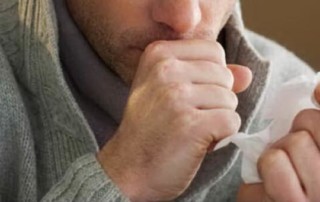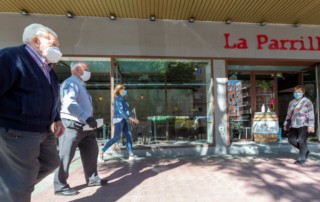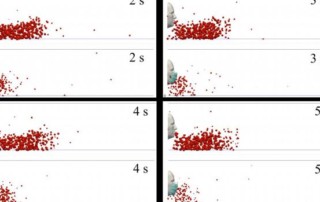COVID-19
UNIC Coronavirus Health and Research Portal
On Coughing and Airborne Droplet Transmission to Humans
Talib Dbouk and Dimitris Drikakis
University of Nicosia, Nicosia, Cyprus
The recent COVID-19 pandemic prompted the need for deeper understanding of the transport of fluids and droplets emanating from our respiratory tracts when we cough, sneeze, speak or breathe. The droplets transport will influence the spread of coronavirus and determine the implementation of guidelines about social distancing, mask wearing, crowded gatherings, as well as everyday practices of social behaviour in private, public and business environments.
The results of our research showed that in open spaces, airborne droplets carriers can travel significantly further than the 2 meters recommended distance due to the wind speed. The issues arising from the past and recent pandemic require a holistic approach to elucidate the open scientific questions and address the practical challenges. Such an approach would require closer interaction between bio-medicine, engineering fluid physics, and social sciences.
Figure 1
Saliva droplet cloud kinematics show the diameter of the droplets resulting from a human cough. Larger droplets settle more rapidly than smaller ones due to gravitational forces. The wind speed is approximately 0 km/h. The total mass of ejected saliva is 7.7 mg, with 1008 total number of droplets. The environment is at ambient temperature, pressure, and relative humidity of 20 oC, 1 atm, and 50%, respectively, with the ground temperature at 15 oC. The droplets in the figure have been scaled up for visualisation purposes.
Figure 2
A human cough: saliva droplet’s disease-carrier particles emanating from coughing do not travel more than 2 m in space at approximately zero wind speed. The environment was considered to be at ambient temperature, pressure, and relative humidity of 20 oC, 1 atm and 50% with the ground temperature at 15 oC.
Figure 3
Saliva droplets can travel large distances, depending on environmental conditions such as wind speed, temperature, pressure and humidity. Wind shown blowing left to right at speeds of 4 km/h (top) and 15 km/h (bottom) can transport saliva droplets up to 6 meters. The droplets in the figure have been scaled up for visualisation purposes.
What Does This Mean?
- In open spaces, airborne droplet carriers can travel significantly further than the 2m recommended distance depending on the wind speed and the environmental conditions. The above is an important finding and Citizens and policy-makers should be aware of it.
- If a person is in the path of the virus cloud, the risk of infection will, most likely, depend on the dosage and time of exposure. Therefore, it is crucial to better understand which scenarios may allow the transmission at longer distances. The present study contributes to advancing the above understanding.
- The dosage and time needed for an infection is still under study and may vary from one person to another. Further research and closer interaction between bio-medicine and engineering fluid physics are necessary to understand the conditions under which patients are being infected.
Non-Technical Summary
The recent COVID-19 pandemic prompted the need for deeper understanding of the transport of fluids and droplets emanating from our respiratory tracts when we cough, sneeze, speak or breathe. The droplets transport will influence the spread of coronavirus and determine the implementation of guidelines about social distancing, mask wearing, crowded gatherings, as well as everyday practices of social behaviour in private, public and business environments.
When sneezing or coughing, larger droplets are formed by saliva, and smaller droplets by mucous coating of the lungs and vocal cords. The smaller droplets are often invisible to the naked eye. Past research has shown that most respiratory droplets do not travel independently on their trajectories. Instead, droplets in a continuum of sizes are trapped and carried forward within a moist, warm, turbulent cloud of air. Although the mechanisms of virus transmission are still under debate, it is widely accepted that aerosol or respiratory droplet transmission is the critical factor for the rapid spread and continued circulation of viruses in humans.
We think that it is likely the dosage and time of exposure which determine whether or not infection will finally occur. Therefore, it is crucial to decide on the scenarios that will allow the transmission to longer distances. Our study aimed at advancing the understanding of the transfer of airborne particle carriers to humans through advanced coupling between droplets and fluid flow modeling and simulation.
The initial modeling configuration of the problem takes into account several parameters that can influence the simulation, including the wind speed in an open environment.
An accurate prediction of the transfer of airborne particle carriers to humans from a cough is governed by the following modeling considerations that must be taken into account:
- The saliva droplets initial size distribution at the onset of the coughing event.
- The human mouth-print of the cough.
- The period of the cough and its intensity (or initial saliva droplets speed).
- The numerical modeling approach to capture the complex varying space and time scales, e.g. both heat and mass transfer considerations, modeling of mass and phase changes due to droplets evaporation, coalescence, break up and turbulent dispersion in interaction with the bulk flow field.
The computational domain in the simulation is a grid in front of the coughing person . The analysis involved running partial differential equations on 1008 saliva droplets and solving approximately 3.7 million equations in total.
Our findings showed that, when a person coughs, the wind speed in an open space environment significantly influences the distance that airborne disease-carrier droplets travel.
- Without surrounding wind speed, the droplets will fall to the ground in a short distance from the person exhaling or coughing. The present analysis shows that the range may not exceed one meter (See Figure 2). A tiny number of particles may travel slightly further longer. Still, their trajectory beyond one meter will already be at a height significantly below half a meter dropping towards the ground. Thus, these droplets may not constitute a risk regarding facial contact of adults at this distance.
- At wind speeds from 4 to 15 km/h, we found that saliva droplets can travel to distances up to 6 meters with decreasing concentrations and liquid droplets size in the wind direction (see Figure 2). Our findings imply that depending on the environmental conditions, the 2 meters social distance may not suffice. Further research is required to quantify the influence of other parameters such as the environment relative humidity and temperature amongst others.
- The droplets cloud will affect both adults and children of different heights. Shorter adults and children could be at higher risk if they are located within the trajectory of falling droplets.
- At a lower wind speed, the droplet total mass reduction occurs more slowly compared to a higher speed, which may prolong the exposure of a human to the droplets if the subject is located within the droplets envelope.
Overall, the results showed that in open spaces, airborne droplets carriers can travel significantly further than the 2 meters recommended distance due to the wind speed. The issues arising from the past and recent pandemic require a holistic approach to elucidate the open scientific questions and address the practical challenges. Such an approach would require closer interaction between bio-medicine, engineering fluid physics, and social sciences.
Figure 1
Saliva droplet cloud kinematics show the diameter of the droplets resulting from a human cough. Larger droplets settle more rapidly than smaller ones due to gravitational forces. The wind speed is approximately 0 km/h. The total mass of ejected saliva is 7.7 mg, with 1008 total number of droplets. The environment is at ambient temperature, pressure, and relative humidity of 20 oC, 1 atm, and 50%, respectively, with the ground temperature at 15 oC. The droplets in the figure have been scaled up for visualisation purposes.
Figure 2
A human cough: saliva droplet’s disease-carrier particles emanating from coughing do not travel more than 2 m in space at approximately zero wind speed. The environment was considered to be at ambient temperature, pressure, and relative humidity of 20 oC, 1 atm and 50% with the ground temperature at 15 oC.
Figure 3
Saliva droplets can travel large distances, depending on environmental conditions such as wind speed, temperature, pressure and humidity. Wind shown blowing left to right at speeds of 4 km/h (top) and 15 km/h (bottom) can transport saliva droplets up to 6 meters. The droplets in the figure have been scaled up for visualisation purposes.
The University of Nicosia (UNIC)
About the University of Nicosia
The University of Nicosia (UNIC) is the largest university in Cyprus, and the largest university in southern Europe that teaches primarily in English, welcoming 12,000+ students from over 70 countries worldwide. The University of Nicosia is a comprehensive university with 6 schools, 20 departments and over 100 degree programs offered on-campus and online.
The University of Nicosia is best known in the fields of medicine, law, blockchain, accounting, education, forecasting and international relations and for a series of partnerships with other leading European universities. UNIC was most recently ranked #106 in its region by QS and #300 to #400 globally in the Times Higher Education Impact rankings.
To learn more about the University of Nicosia, please see: https://www.unic.ac.cy/
UNIC’s COVID-19 Response
University of Nicosia faculty across a variety of academic disciplines are actively engaged in research and analysis and serving in scientific / public policy roles supporting the global COVID-19 response.
For more information about the University of Nicosia’s work relating to COVID-19 including potential collaboration, please see: https://www.unic.ac.cy/coronavirus/
Contact Information
For more information about this study, please contact Prof Dimitris Drikakis at [email protected].
For more information on our COVID-19 related research in general, please contact UNIC at [email protected].
Press Coverage
Articles and press mentions in global media about the research.
Coronavirus: a qué distancia deberían permanecer las personas en un parque
Son varios los países de Europa que ya han comenzado a flexibilizar el aislamiento social preventivo y obligatorio debido a que el pico de contagios del virus en lugares como Italia y España disminuyó significativamente. Sin embargo, a pesar de que el nivel de contagios y fallecidos empezó a reducirse, las medidas preventivas se deben seguir implementando. La Organización Mundial de la Salud (OMS) recomienda un mínimo de un metro de separación entre persona y persona para mantener la distancia [...]
¿La distancia social de 2 metros es suficiente? Los expertos creen que no
En España hemos aceptado que la distancia social de 2 metros es suficiente para evitar contagiarnos del coronavirus. Pero, ¿realmente es suficiente? Un estudio elaborado por científicos de la Universidad de Nicosia, en Chipre, apunta a que no. Y es que, en función de diferentes factores ambientales, como el viento, las gotas que expulsamos al toser y al estornudar, potenciales portadoras del virus, pueden viajar hasta 6 metros. Los expertos han realizado un estudio acerca del transporte, la dispersión y [...]
Coronavirus | Se c’è vento forte, un metro di distanza non basta
Coronavirus | Se c’è vento moderato o forte, un metro di distanza non basta Coronavirus, uno studio pubblicato rivela che bisogna mantenere distanze di sicurezza diverse a seconda dell’assenza totale di vento, o della presenza di vento leggero o forte. Uno studio pubblicato sulla rivista Physics of Fluids analizza in che modo vengano distribuite le goccioline emesse da un soggetto che tossisce a seconda se ci sia assenza di vento, un vento leggero o un vento più forte. Gli autori [...]
Coronavirus: Dos metros pueden no ser siempre suficiente para evitar el contagio
Una tos con una leve brisa de 4 kilómetros por hora puede impulsar las gotas de saliva a cinco metros y medio Las autoridades sanitarias lo han repetido muchas veces: El distanciamiento social puede ser la mejor mascarilla. Por eso, recomiendan mantener una distancia de dos metros entre individuos para evitar la posible transmisión del Covid-19. Sin embargo, puede no ser suficiente en ciertas circunstancias, según concluye un nuevo estudio sobre cómo las partículas viajan por el aire cuando las [...]
Los dos metros de distancia no serían suficientes para evitar contagios por coronavirus con viento suave
El comportamiento y evolución del coronavirus continúa siendo el objetivo primario de los estudios puestos en marcha desde el inicio de la pandemia global, para conocer cómo se propaga el nuevo virus. La revista 'Physics of Fluids’ publicó un artículo que mostraba el hallazgo de los investigadores de la Universidad de Nicosia (Chipre) Talib Dbouk y Dimitris Drikakis, quienes descubrieron que incluso con una brisa ligera de 4 kilómetros por hora, la saliva es capaz de viajar hasta cinco metros [...]
Μελέτη για τον κορωνοϊό: Tα σταγονίδια σάλιου μπορούν να «ταξιδέψουν» πάνω από πέντε μέτρα
Προκύπτει ότι ακόμα και ένα ελαφρό αεράκι, ταχύτητας 4 χιλιομέτρων/ώρα, μπορεί να βοηθήσει τα μικροσταγονίδια σάλιου να «ταξιδέψουν» 5,4 μέτρα σε μόλις 5 δευτερόλεπτα - Ο καθηγητής του Πανεπιστημίου της Λευκωσίας, Δημήτρης Δρικάκης, υποστηρίζει ότι οι ενήλικες με χαμηλό ανάστημα και τα παιδιά ενδεχομένως να διατρέχουν υψηλότερο κίνδυνο Σε μελέτη που δημοσιεύθηκε στο επιστημονικό περιοδικό Physics of Fluids, ο καθηγητής του Πανεπιστημίου της Λευκωσίας, Δημήτρης Δρικάκης και ο συνεργάτης του Ταλιμπ Ντμπουκ, υποστηρίζουν ότι ακόμα και ένα ελαφρό αεράκι μπορεί να βοηθήσει [...]
Coronavirus, l’allarme degli scienziati: le goccioline di saliva all’aperto possono arrivare fino a 6 metri
È sufficiente una leggera brezza perché all'aria aperta le goccioline di saliva che veicolano il virus Sars-CoV-2 possano superare la distanza di 6 metri. All'aperto, quindi, il distanziamento di 2 metri potrebbe non essere sufficiente. A indicarlo la ricerca pubblicata sulla rivista Physics of Fluids da Talib Dbouk e Dimitris Drikakis, dell'università di Nicosia, a Cipro... Read more here: Coronavirus, l'allarme degli scienziati: le goccioline di saliva all'aperto possono arrivare fino a 6 metri - L'Unione Sarda.it
Coronavirus en España: Los dos metros de distanciamiento, insuficientes si hace viento
Las medidas actuales de distanciamiento físico, que obligan a guardar dos metros de distancia entre personas para evitar la propagación del coronavirus, podrían ser insuficientes en determinadas condiciones ambientales como la velocidad del viento, que puede propagar las gotas de saliva que se desprenden de la tos a más de 5 metros de distancia. Así lo advierte hoy martes un estudio publicado en la revista científica «Physics of Fluids» y liderado por los investigadores Talib Dbouk y Dimitris Drikakis, del [...]
Simulação mostra como vírus se espalha, apesar do uso de máscara. Vídeo
Simulação mostra como vírus se espalha, apesar do uso de máscara. Vídeo Em meio à pandemia de Covid-19, o uso de máscaras de proteção tem sido recomendado por entidades de saúde para conter a disseminação do novo coronavírus. No entanto, uma simulação realizada por pesquisadores da Universidade de Nicósia, no Chipre, mostra que, apesar de reduzir as chances de transmissão, a proteção não impede que gotículas produzidas ao tossir, espirrar, falar e, até mesmo, respirar se espalhem pelo ambiente. Os [...]
La tos repetitiva degrada gravemente la eficacia de las mascarillas
Cada vez más investigaciones científicas apuntan a la eficacia de las mascarillas como método de freno del nuevo coronavirus. Sin embargo, existen menos estudios sobre cómo se degradan con el uso, a pesar de que mucha gente las reutiliza en varias ocasiones, incluso por encima de su vida útil. Por ello, un equipo de la Universidad de Nicosia (Chipre) acaba de publicar en « Physics of Fluids» unas conclusiones un tanto alarmantes: incluso con mascarilla, las gotas de saliva podrían viajar más de un metro de [...]




